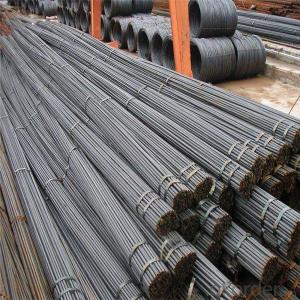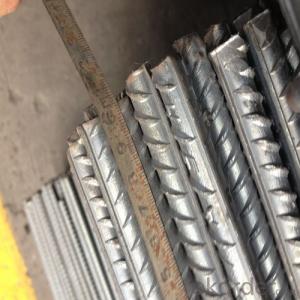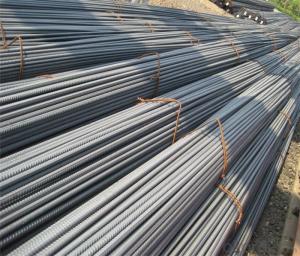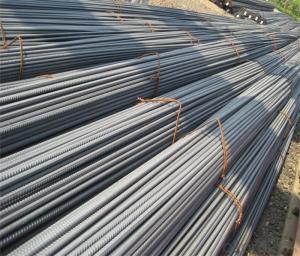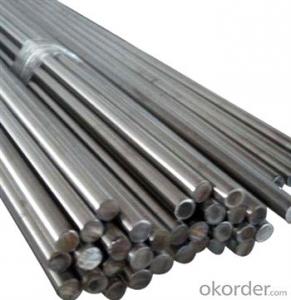GB HRB400 HRB500 BS4449 ASTM A615 GR40 GR60 steel rebar
- Loading Port:
- China main port
- Payment Terms:
- TT OR LC
- Min Order Qty:
- 1000 m.t.
- Supply Capability:
- 19863 m.t./month
OKorder Service Pledge
OKorder Financial Service
You Might Also Like
Specification
Rebar called reinforcing bars, steel rebar is metal bars often used in construction for pouring concrete or
supporting walls and columns. The rebar can be smooth, though they are frequently manufactured with
deformations that create greater texture to which concrete can adhere, creating a stronger bond that helps
prevent cracking of concrete. These deformations do not create weaknesses in the rebar, and when rebar
is measured to determine its diameter, it is typically measured at the narrowest point. Strength grades
indicate the amount of pressure the steel rebar can withstand, and grade and diameter are typically presented
in both imperial and metric units
Our Advantage:
High quality steel products from 1 class mills in China
Reasonable price
Professionalism of the products
On-time delivery
Complete documents and certificates
Sincere service to meet our clients' requirements
Product Description :
Chemical composition (%): | Steel | C | Si | Mn | P | S | Ceq | ||||
HRB335 |
0.25 |
0.80 |
1.60 |
0.045 |
0.045 | 0.52 | |||||
HRB400 | 0.54 | ||||||||||
HRB500 | 0.55 | ||||||||||
Mechanical properties | Steel | Rel/ MPa | Rm/ MPa | A/ % | Agt/ % | ||||||
≥ | |||||||||||
HRB335 | 335 | 455 | 17 |
7.5 | |||||||
HRB400 | 400 | 540 | 16 | ||||||||
HRB500 | 500 | 630 | 15 | ||||||||
Package: | Standard export packing or as customer's request | ||||||||||
Application: | Construction, building, bridge, road. ect | ||||||||||
Payment terms | 1).100% irrevocable L/C at sight. | ||||||||||
Delivery time | 15-30 days after receipt of L/C or deposit by T/T | ||||||||||
Features
1、Pure steel quality, stable chemical contents, small tolerance.
2、Constant Quality, good drawing performance.
3、High dimension accuracy degree, accuracy degree of Level C up to 80%, smooth surface, less scale, easy to be pickled.
4、Automatic bundling with 4 lines by Machine in tidy and good looks
5、Big high quality percentage, small coil percentage, and heavy coil weight for Hard Coil.
6、High sorbitizing percentage.
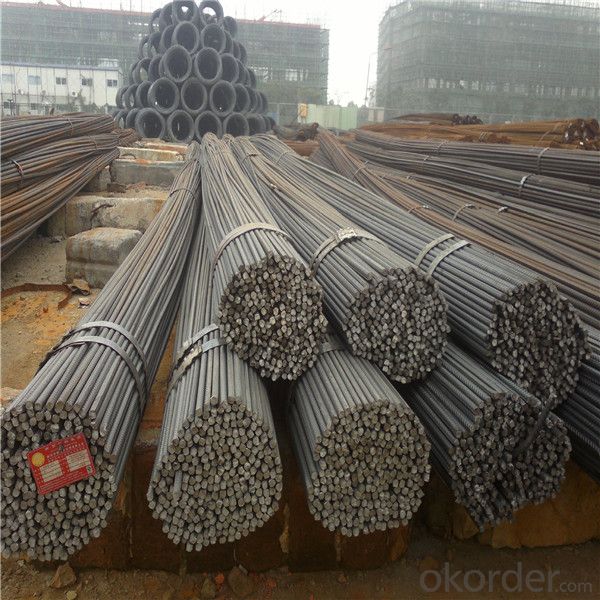
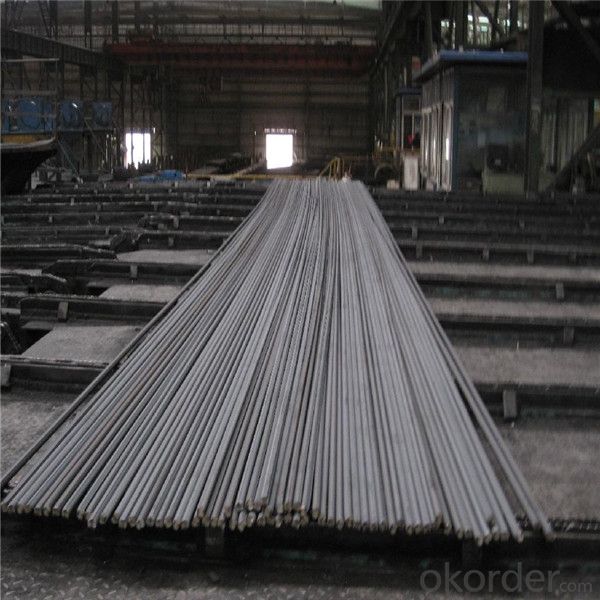
Packing:
In bundles, each bundle weight 3.5 tons. Load by container or by bulk verssel.
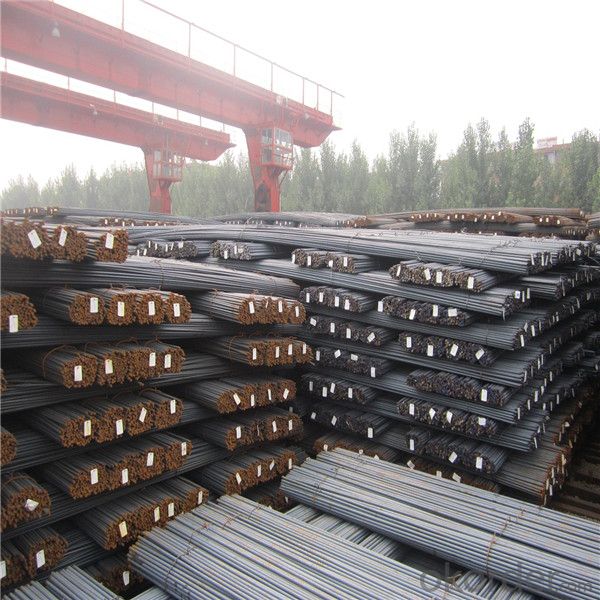

Our service
(1) We cooperate with famous factories with advanced equipment and well trained workers.
(2) We can provide factory price with trading company service.
(3) We continuously work on the improvement of our processes, guaranteeing consistently high standards
of quality to keep none compensation.
(4) We guarantee 24 hours response and 48 hours solution providing service.
(5) We accept small order quantity before formal cooperation.
(6) We deliver the agreed quality at the agreed time, reacting to changes in customer wishes in a flexible way.
(7) Due to our volume and selling power, we have excellent freight rates with shipping lines.
(8) We strive to always be fair and honest in our dealings with customers.
(9) We strive to work together with customers to achieve much more than we can achieve alone.
(10) Through our passion and commitment we aim to be a market leader in all our key markets. To maintain
our position as market leader we must continue to add value in all that we do.
FAQ:
1.Q: What's your MOQ(minimum order quantity)?
A: One full container, mixed acceptable .
2. Q: What's your packing methods?
A: Packed in bundle or bulk ..
3. Q: How can I buy CNBM products in my country?
A:Please send us an inquiry or email ,we will reply to you if there is distributor in your country
4. Q: Can we visit your factory?
A: Warmly welcome. Once we have your schedule, we will arrange the professional sales team to follow up your case.
5. Q: How long does it take to get the product if i place an order?
A:With the process of your requirements,we will pack and deliver in 3-7 days. If it is by sea shipment,it will take 15-45 days depending on different locations
- Q: What is the role of steel rebars in the construction of dams and reservoirs?
- Steel rebars play a vital role in the construction of dams and reservoirs as they provide reinforcement and strength to the concrete structures. These rebars are strategically placed throughout the concrete to enhance its tensile strength, allowing it to withstand the immense pressure exerted by the water. By reinforcing the concrete, steel rebars help prevent cracks and structural failures, ensuring the long-term durability and stability of the dam or reservoir.
- Q: Can steel rebars be used in renovation or retrofitting projects?
- Absolutely, renovation or retrofitting projects can indeed make use of steel rebars. In construction, steel rebars are frequently employed to fortify concrete structures and they can also be utilized in renovation endeavors to bolster pre-existing structures. When refurbishing or retrofitting a building, it often becomes imperative to reinforce the current structure in order to comply with modern building codes or support additional burdens. Strengthening walls, columns, beams, or slabs can be achieved by incorporating supplementary reinforcement into the concrete, thanks to the utilization of steel rebars. By integrating steel rebars into a renovation project, the building's structural soundness can be enhanced, thereby ensuring its safety and durability.
- Q: Why is thread steel thinner than crude?
- Thread steel is used for the construction of reinforced concrete facilities, his material is generally low alloy steel grades is generally 16Mn (16 Mn low-alloy steel), or 45 carbon just, their yield strength is above 350Mpa, tensile strength 500Mpa, low carbon steel round steel than ordinary much higher (after heat treatment of the steel strength than low carbon steel nearly twice as high or higher)
- Q: How do steel rebars contribute to the strength of concrete?
- Steel rebars contribute to the strength of concrete in several ways. Firstly, they enhance the tensile strength of concrete, which is otherwise relatively low. While concrete is excellent in compression, it is weak when it comes to resisting tension. This is where steel rebars come into play. By embedding them within the concrete, they provide additional strength and help prevent the formation and propagation of cracks. Secondly, steel rebars improve the bond between concrete and the reinforcement material. The ribbed surface of the rebars creates a better grip with the concrete, ensuring a stronger bond. This bond is crucial as it allows the concrete and steel to work together, distributing the loads and minimizing the risk of structural failure. Furthermore, steel rebars increase the overall durability and longevity of concrete structures. They resist corrosion, which is a significant concern in coastal or high humidity areas. The corrosion resistance of rebars ensures that the concrete remains structurally sound for a longer period, reducing maintenance costs and extending the lifespan of the structure. In addition to their strength-enhancing capabilities, steel rebars also contribute to the structural stability of concrete elements. They assist in reinforcing critical areas such as beams, columns, and foundations, where high loads and forces are present. By providing additional support and reinforcement, steel rebars help prevent excessive deflection, bending, or failure of these elements under heavy loads. In summary, steel rebars play a vital role in enhancing the strength of concrete structures by improving tensile strength, bond strength, durability, and overall structural stability. Their incorporation in concrete elements is essential for ensuring the longevity and safety of various construction projects.
- Q: How are steel rebars protected against mechanical damage during construction?
- Steel rebars are protected against mechanical damage during construction through a process called bar caging. This involves enclosing the rebars in a wire mesh or steel cage, which acts as a protective barrier and prevents them from being easily damaged or displaced during the construction process. Additionally, rebars can also be covered with plastic sleeves or caps to provide an extra layer of protection.
- Q: Can steel rebars be welded to other steel components?
- Yes, steel rebars can be welded to other steel components. Welding is a common method used to join steel structures, including rebars, to create strong and durable connections.
- Q: Can steel rebars be used in structures with high chemical resistance requirements?
- When considering structures with high chemical resistance requirements, it is important to take into account the specific chemical environment in which the structure will be exposed. Although steel rebars generally have resistance to many common chemicals, certain aggressive substances like acids or alkaline solutions can cause corrosion and degradation of the rebar over time. Hence, alternative materials like stainless steel rebars or fiber-reinforced polymer (FRP) rebars may be necessary in such cases as they possess superior resistance to chemical attack. Moreover, to minimize the effects of chemical exposure on steel rebars, proper design, construction, and maintenance practices should be followed. Factors such as the type and concentration of chemicals, temperature, humidity, and exposure duration should all be carefully evaluated to determine if steel rebars are suitable for a structure with high chemical resistance requirements. To ensure the best choice of materials for the specific chemical environment, it is recommended to consult with a structural engineer or corrosion specialist.
- Q: Can steel rebars be used in tunneling and mining operations?
- Yes, steel rebars can be used in tunneling and mining operations. Rebars, which are steel bars commonly used to reinforce concrete structures, can also be employed in underground construction projects such as tunnels and mines. These steel bars provide additional strength and stability to the structures in these environments, ensuring durability and safety. In tunneling projects, rebars are often embedded in shotcrete or concrete linings to enhance the structural integrity of the tunnel walls and prevent collapse. Similarly, in mining operations, rebars are used to reinforce the roofs, walls, and support structures within the mine, safeguarding against potential hazards such as rockfalls and cave-ins. The use of steel rebars in tunneling and mining operations is crucial for maintaining the integrity and stability of these underground structures.
- Q: Can steel rebars be used in dam construction?
- Yes, steel rebars can be used in dam construction. They are commonly used to reinforce concrete structures, including dams, to enhance their strength and durability.
- Q: Are there any alternatives to steel rebars in construction?
- Yes, there are alternatives to steel rebars in construction. Some common alternatives include fiberglass rebars, carbon fiber rebars, and basalt rebars. These alternatives offer advantages such as being lightweight, corrosion-resistant, and having high tensile strength. Additionally, materials like bamboo, timber, and certain polymers can also be used as alternatives to steel rebars in specific construction applications.
Send your message to us
GB HRB400 HRB500 BS4449 ASTM A615 GR40 GR60 steel rebar
- Loading Port:
- China main port
- Payment Terms:
- TT OR LC
- Min Order Qty:
- 1000 m.t.
- Supply Capability:
- 19863 m.t./month
OKorder Service Pledge
OKorder Financial Service
Similar products
Hot products
Hot Searches
Related keywords
